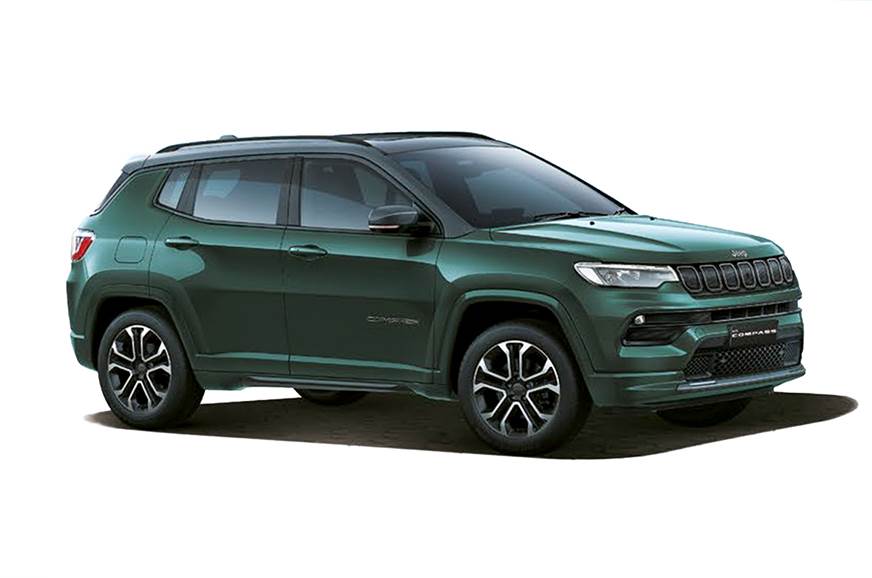2017 Jeep Compass review, road test
The Jeep we’d all been waiting for came, saw and has seemingly conquered. Time to see if the Compass is as good as it’s made out to be.
Published on Dec 02, 2017 08:00:00 AM
1,54,393 Views
Follow us on

LED on headlight is parking light. Halogen light lower down is the DRL.

Seven-slat grille is trademark Jeep. Functional air inlet sits below.

Lip at base of front bumper extends really low but is designed to flex.
First things first, the model we get in India is the all-new second-generation Compass. Unlike its predecessor that was born in the troubled Daimler Chrysler era (Chrysler owned Jeep), this one is a product wholly developed and built under Fiat Chrysler Automobile. Fiat’s ‘Small Wide 4x4’ monocoque platform serves as the building block for the Compass and the design started from a clean white sheet of paper.
If you’ve not seen one in the metal already, you should know that the Compass is actually not as large as it appears in the pictures. The Compass’ near-4.4m length slots it in between the Hyundai Creta and the Tucson in size. What the Compass has oodles of, though, is presence. It’s a handsome and well-turned-out SUV that looks unmistakably Jeep what with that trademark seven-slat grille, and flared, and almost-square wheel arches. The family look is strong and, when viewed from the front, the Compass can easily pass off as a junior Grand Cherokee. At the same time, the Compass’ distinctive shark-fin-like D-pillar and the manner in which the roof drops down towards the rear make it abundantly clear this is no Xerox job either. Detailing is nice and the chrome highlight that runs from the A-pillar onwards and slickly wraps itself around the rear windscreen, is particularly well executed. Styling at the rear is neat and inoffensive. If there’s anything to bring up it’s that the sizeable front overhang disturbs the proportions a wee bit. Also, the 17-inch wheels look a size too small. And what’s with the rear wheels being offset towards the front under their large wheel arches?
An area where the Jeep does get a double thumbs-up is build quality. Shut lines are consistently tight, there’s not a panel that seems flimsy and everything feels properly bolted and glued. Notably, 70 percent of the Compass’ body is made from rigid high-strength steel. It’s also worth bringing in that the Compass is a Euro NCAP 5-star rated car. While the safety rating does not apply to the India-spec model (the European-spec model features advanced safety aids such as autonomous emergency braking as standard), it is at least reassuring to know that the Compass exhibited impressive structural integrity in each of its crash tests.
The 4x4 Compass comes with Jeep’s Active Drive all-wheel-drive system that features a clever rear-axle disconnect. The system works in conjunction with the Selec-Terrain Traction Management system that offers four modes – Auto, Snow, Sand and Mud, each with its own AWD calibration and electronics settings. In the default Auto mode, engine power is channelled solely to the front wheels in the interest of best efficiency, but on detecting a need for additional traction, the driveline reconnects (all within 300 milliseconds) to send requisite power to the rear wheels. Impressively, up to 100 percent of engine power can be sent to any one of the four wheels, should the need arise, and you also have the option to manually lock the AWD system in Auto mode.
Front-wheel drive or all-wheel drive, all Compasses run on Firestone all-season tyres, use electric power steering, and feature all-independent suspensions with frequency selective dampers. Developed by Koni, these hydraulic dampers house an additional valve that, in effect, mechanically controls the oil flow and hence the damping force, in response to the frequency of suspension inputs. On rough surfaces (high frequency), the valve eases the flow for a smoother ride while during cornering (low frequency) oil flow is restricted for better body control.
Copyright (c) Autocar India. All rights reserved.







Comments
Member Login
Personal Details
No comments yet. Be the first to comment.